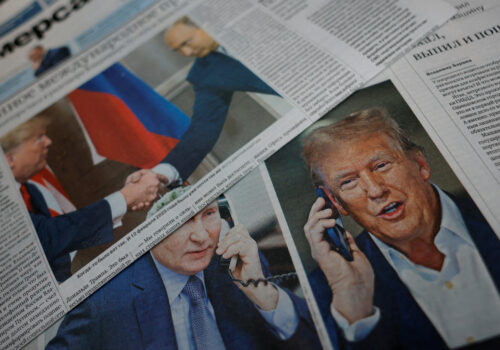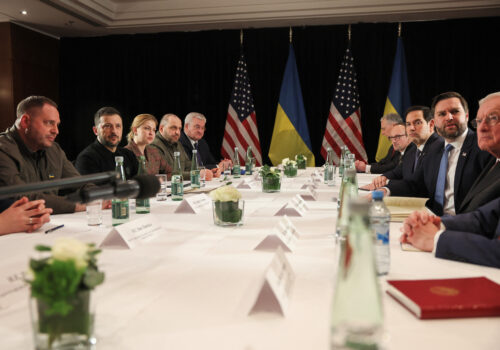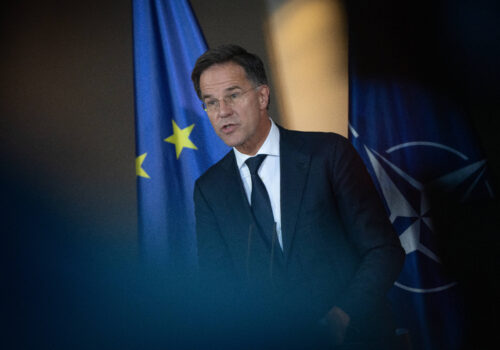Revitalizing the US defense industry is best done with European allies
In 2024, NATO marked its seventy-fifth anniversary—celebrating an institution that shepherded the United States to victory in the Cold War and has augmented US global leadership in the decades since. However, at the recent Munich Security Conference, many questioned whether the transatlantic alliance had fractured beyond immediate repair following Vice President JD Vance’s stark message for Europe. In asserting that threats to European security emanated mainly from within Europe, rather than from Russia, Vance alienated key allies. This rhetoric, coupled with US President Donald Trump’s accusations that Ukrainian President Volodymyr Zelenskyy is a “dictator” after locking both Europe and Ukraine out of negotiations with Russia, strikes directly at the heart of transatlantic values and interests.
Historically, the transatlantic alliance has been able to navigate tensions, even bitter ones, recognizing that allies are stronger when working together. And the United States still maintains an enduring interest in European stability. However, the international security environment is more volatile now than at any time since World War II. Adversaries are strengthening their cooperation and becoming more assertive. What’s more, a negotiated settlement in Ukraine that favors Russia could embolden Russian President Vladimir Putin to further his revanchist ambitions elsewhere in Europe.
Against this backdrop, the Alliance’s unity is vulnerable. Any daylight between the United States and its allies will be exploited by its adversaries. Not only does recent rhetoric undermine longstanding US policies, it also contradicts some of the strategic priorities laid out by the Trump administration. Notably, deepening these growing fissures within the Alliance is antithetical to the US goal of strengthening its defense industrial capacity. Vance’s vision for US-European relations failed to imagine the ways in which the United States is made stronger and more competitive by mobilizing the industrial and innovative might of its closest friends. By combining their efforts and sharing risks, the United States and Europe can revitalize their defense industrial bases at the speed necessary to confront today’s growing global threats.
The US defense industrial base is not keeping pace with current demand. Decisions made decades ago to consolidate the US defense industrial base and prioritize military kit for counterinsurgency efforts from the 1990s onward left the US defense industrial base unable to meet the demands associated with great power competition. This is evidenced by struggles to replenish stocks amid skyrocketing demand from allies and partners, with foreign military sales posting a record one hundred billion dollars in sales in 2024. While major US defense contractors have taken some steps to increase production, such as expanding shifts in manufacturing facilities, corporate boards have been risk-averse when it comes to investing in more physical plant, fearing that the currently hot demand signals might soon cool. As a result, delivery timelines for many major defense items have grown beyond five years. This is far too long in today’s dynamic technology and threat environment, and these slow timelines are causing some partners to look elsewhere for faster delivery of equipment, whereas in the past they turned to their first preference, the United States.
In Europe, the Trump administration gets two things right. Europe needs to play a greater role in its own security and raising defense expenditure benchmarks is a necessary step for European NATO allies to achieve this. However, European industry alone cannot match rising defense investments with the advanced and exquisite systems necessary to resource NATO’s defense plans. As opposed to the US situation, European defense industries are fractured along national lines and even more limited in overall capacity. While Europe is taking some steps to address these vulnerabilities, it cannot yet achieve results on its own.
There is no silver bullet to address the enervated transatlantic defense industrial bases, and the United States and Europe require different remedies to boost their respective industrial capacities. But abating these issues will take time. And time is a commodity that the Alliance does not have.
Instead, the transatlantic alliance must harness comparative advantages in industrial and innovative might in the short term to address these critical vulnerabilities. By finding ways to share risk and rewarding innovative startups that are willing to take risks, allies can create windfall effects that can begin to ameliorate production timelines, boost defense capacity, and improve the speed and scale with which they can deliver kit to their forces.
Already, there are nascent efforts to capitalize on industrial synergies, sharing risks across the ocean. For example, the Polish defense manufacturer PGZ will co-produce Javelin anti-tank weapons with US industry in Poland. The NATO Supply and Procurement Agency is also helping facilitate efforts among allies to co-produce Patriot missiles in Germany. Ultimately, these efforts should allow the US defense industry to develop creative solutions for domestic capacity constraints while also sharing risk across international partners, which makes it more palatable for industries to invest in new or upgraded manufacturing facilities. Looking ahead, these efforts need greater support to achieve meaningful results—and this often requires the removal of bureaucratic hurdles that inhibit shared defense industrial ambitions. One potential model for future initiatives to emulate, for example, is the careful and conditional amendment of some licensing requirements under the International Traffic in Arms Regulations among the countries in the Australia-United Kingdom-United States (AUKUS) partnership, which helped facilitate defense trade and cooperation. (Though, this example does require partners to build an export control regime that meets US standards and other venerable rules.)
Cooperative efforts, such as those in Poland and Germany, demonstrate a growing appetite on the part of Washington’s allies and partners to collaborate with the United States on its security priorities and to share risks in a way that bolsters the position of US industries (and those of the Alliance as a whole). This kind of cooperation is going to be necessary for the Trump administration to accomplish its goals of “expanding defense industrial base capacity on both sides of the Atlantic,” a priority emphasized in a call between US Secretary of Defense Pete Hegseth and NATO Secretary General Mark Rutte.
The past few weeks will undoubtedly be remembered as a tenuous time in the transatlantic relationship. However, it is important to note that this longstanding Alliance rests on more than just shared values. It also provides tangible economic and security benefits for the United States and Europe. Revitalizing defense industrial might—a shared goal on both sides of the Atlantic—is an opportunity to begin repairing the schism among allies while providing the necessary military capabilities to safeguard transatlantic security in the years ahead.
James A. Hursch is a nonresident senior fellow with the Transatlantic Security Initiative in the Scowcroft Center for Strategy and Security at the Atlantic Council. He previously served as the director of the Defense Security Cooperation Agency and as deputy defense advisor at the US Mission to NATO.
Kristen Taylor is an assistant director with the Transatlantic Security Initiative.
Further reading
Thu, Feb 20, 2025
What Europeans think of Trump’s approach to Ukraine (and what they might do next)
New Atlanticist By
European leaders are waking up to calls from the Trump administration to take the lead on security for Ukraine. Atlantic Council experts share what that might look like from Berlin to Vilnius.
Mon, Feb 17, 2025
Dispatch from Munich: Sorting signal from noise in the Trump team’s Ukraine moves
New Atlanticist By John E. Herbst
Despite the Trump team’s twists and turns regarding the war in recent weeks, the contours of a plan that could produce a durable peace remain clear.
Thu, Nov 21, 2024
How Europe can save NATO
New Atlanticist By Hans Binnendijk, Timo S. Koster
By the June 2025 NATO Summit in The Hague, European allies must make real progress in taking on more of the defense burden on the continent.
Image: US Secretary of Defense Pete Hegseth, alongside Polish Deputy Prime Minister Wladyslaw Kosiniak-Kamysz, visited the Army Prepositioned Stocks-2 (APS-2) site in Powidz, Poland on February 15, 2025.


